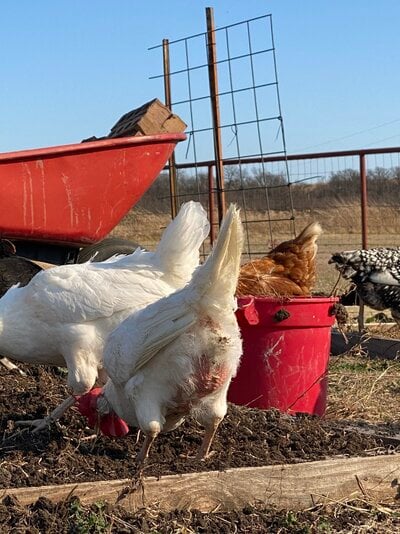Navigation
Install the app
How to install the app on iOS
Follow along with the video below to see how to install our site as a web app on your home screen.
Note: This feature may not be available in some browsers.
More options
You are using an out of date browser. It may not display this or other websites correctly.
You should upgrade or use an alternative browser.
You should upgrade or use an alternative browser.
Leghorn with bare swollen bottom
- Thread starter Katbiemer
- Start date
Pics
More options
Who Replied?What is your location? Spring or fall where you live? I can't see the detail in the photo well enough to make out any new pin feathers coming in on the bare butt. All I see are broken feathers. Can you confirm?
If the flesh feels fatty in the swollen area, rather than like fluid, this hen may just be obese. But if the swelling feels more like fluid, then she could be harboring a reproductive infection. Her poop would be yellow and runny like a soft boiled egg. Have you seen a poop sample from her?
If the flesh feels fatty in the swollen area, rather than like fluid, this hen may just be obese. But if the swelling feels more like fluid, then she could be harboring a reproductive infection. Her poop would be yellow and runny like a soft boiled egg. Have you seen a poop sample from her?
- Thread starter
- #3
It's true ascites (water belly) can cause similar conditions.Suggestions or thoughts?
Possibly parasites (my current top thought) as her other feathers are in ragged condition also but because of the angry skin. It *looks* more dried out and leathery like from the outside than swollen/puffy from the inside.. what I can make out and just for discussion purposes.
How old is she and when did she last molt? What is her feed routine including treats and supplements?
Checking after dark with a flashlight prevents any chasing and keeps things a lot calmer!

- Thread starter
- #5
Since her poop is normal, the swelling you see is likely fat. That isn't good, but it's not immediately life threatening. If you feed scratch grain and corn every day, you might want to reduce the amount and frequency or risk chickens getting fatty liver disease.
Eggs are still safe to eat.She turned two this month. She just got out of molt a few months back.
Are her eggs safe to eat?
Any suggestions for how to treat her? Should I treat the other hens too?
First verify what condition we are working with. A picture can only tell so much, when I adjust my screen brightness it looks irritated still but less angry.
If it is parasites.. using a permethrin based "horse fly spray" is very affordable, effective, and easy to use against most parasites and in most locations. A small spritz to the skin just below the vent, under each wing pit, and to the back of the neck at the base of the head.. to EACH chicken so others without symptoms don't just become prime targets. Follow up in 10-14 days to completely break the life cycle. Heavy infestations may require a third treatment. I also spray roosts and lay boxes, noting it is NOT safe for use on cats. There are powder versions and some other methods either more expensive (elector psp) or requiring egg withdrawal (Ivermectin). This requires NO egg withdrawal and doesn't make dust to breathe in addition to the cost factor is the main reason I'm suggesting it, again only IF needed.
I do agree, I thought dang she looks "big" for a leghorn, making me question breed correctness. But fat doesn't equal bald or irritated.
I would question feed routine again.. but I would *expect* any of the other breeds to show (nutrient) deficiency or excess caloric intake issues before a leghorn would. Doesn't make my expectation true since ALL are individuals, throwing it out there just for consideration.
Comparing her to what you see on the others with close inspection (after dark tonight) may help give you a better ideal. My number one reason for having a "head lamp".
- Thread starter
- #8
Thank you for the replies. I think it’s the angle of the photo. Our two leghorns arre smaller than most of our other hens.
We only feed them scratch every few days and just about a half cup or less sprinkled in a large area for 13 birds.
I think our chicken feed is 18% crude protein. They do get vegetable scraps every day from our kitchen and the occasional scrambled eggs.
We only feed them scratch every few days and just about a half cup or less sprinkled in a large area for 13 birds.
I think our chicken feed is 18% crude protein. They do get vegetable scraps every day from our kitchen and the occasional scrambled eggs.
New posts New threads Active threads
-
Latest threads
-
-
Underdeveloped hen: cull or not?
- Started by JustOhkay
- Replies: 3
-
-
-
-
-
Threads with more replies in the last 15 days
-
-
-
24 hour old chick with legs and feet issue.
- Started by Beckys Birds
- Replies: 111
-
Need advice for the best vines and plants for in a chicken run!
- Started by ChickenShepherd_6116
- Replies: 98
-
-
×




